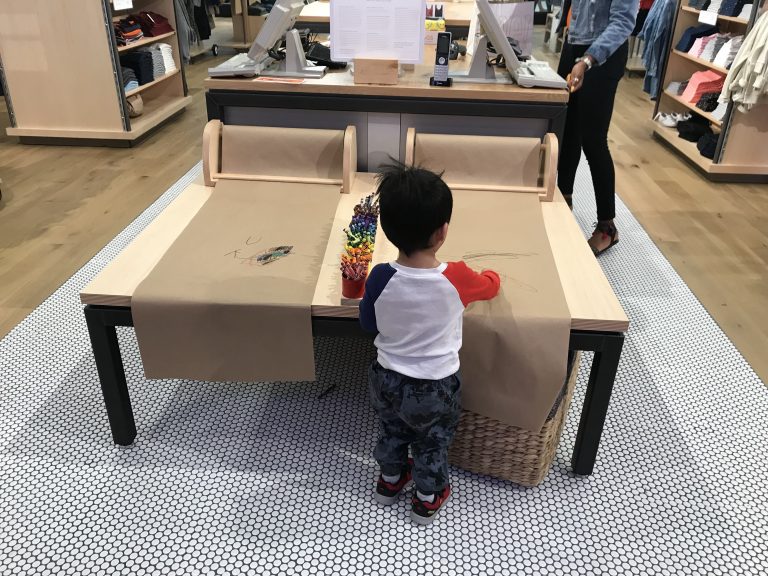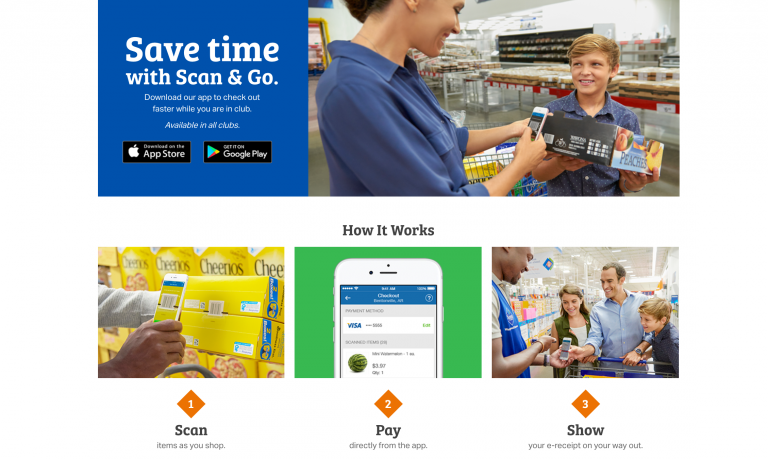Question: are you planning to bring anything new to the in-store experience? If your answer is “no,” then brace yourself. The coming years could be rough for your retail business.
Why? Because competition in the retail industry is fiercer than ever. Between ecommerce sites and subscription services, consumers have plenty of choices when it comes to where they spend their time and money.
To stay competitive, you need to give them compelling reasons to come down to your store and shop.
Looking for ways to do just that? Below are 7 tips and examples to get you started.
1. Have each associate go from being a “salesperson” to being a consultant, expert, or even friend
This TIME article said it best: the retail worker of the future is “cool, charismatic, and better paid.”
It’s good to have the in-store technology and other bells and whistles, but don’t lose sight of the fact that your front-line employees are the biggest and most important creators of the in-store experience.
Any retailer that wants to stay competitive needs to step up their game when it comes to staff hiring and development. It’s no longer enough to train employees on your products and store policies — these things are just the bare minimum.
You also need to train them to relate better to shoppers. Your associates should have the ability to connect with customers in a memorable way. This often means shifting from being a “salesperson” to being an expert, consultant, or even friend.
Need an example? Freelance writer and content strategist Alexandra Sheehan recalls an interaction she saw between one of her friends and the associates from a tuxedo shop. Here’s how it went down:
“One of my friends was getting married in a couple of months and stopped by the store where he and his groomsmen were getting their tuxedos,” she wrote. “He was greeted by name and with a cold beer. Handshakes and hugs all around.”
“When we left, I turned to my friend and asked, ‘Do you know them?’ He said, ‘Yeah, they’re helping me with my tux.’”
“Their entire relationship was forged on a transaction, a customer-brand interaction. But it was authentic. I’m not in the market for a tux, but if I were, I’m sure that’d be my first stop.”
Consider the above example when you’re hiring or training your associates. Ask yourself, how can you and your staff uplevel your relationships with your customers? If your customers still see you and your employees as “salespeople,” what can you do to change their perception?
Find the answers to these questions and use them to reinvigorate your staffing and customer service strategies.
2. Let guests have some hands-on fun
Are you allowing your customers to experience your products or are those items just sitting inside boxes on a shelf? If it’s the latter, then it’s high time to mix things up. Figure out how you can present your merchandise in unique and experiential ways.
The Game Chest at the Del Amo Fashion Center is doing a great job at this. Founded by three local moms, The Game Chest combines board games with toys and allows guests to have hands-on fun with their products.
A lot of their toys are openly displayed so children can literally play with large train sets and blocks in-store. The folks at the store also offer toy demos so customers can try them before buying. Prefer to rent toys? The Game Chest has a rental service, too.
And for board or card game enthusiasts, they have a special area in the store with tables and chairs where people can play. Events such as classes and tournaments also take place in the store.
Another retailer that’s encouraging hands-on fun is kids’ apparel store, Gymboree. The branch at the Del Amo Fashion Center has an area where kids can color and draw. This helps the children stay occupied while parents shop.

Now it’s your turn. Can you ideate and test ways to promote hands-on fun in your store? Perhaps you can allow customers to play with your products. Or maybe you can promote activities that keep the little ones busy. Find what works and see how shoppers react.
3. Make sure your physical and digital stores work together
If you have an online store (and you totally should), see to it that your ecommerce site works hand in hand with your physical location(s). Remember, modern consumers are using multiple channels and devices in their shopping journeys. Aside from shopping in-store, they’re using their phones, computers, and tablets to research and buy products.
For this reason, it’s important to not just have a presence on different channels, but you need to enable customers to shop across physical and digital channels seamlessly. In other words, you need to be an omnichannel retailer. Here’s how:
Implement click-and-collect
Click-and-collect, a service that lets shopper buy online and pick-up in-store, isn’t just convenient for customers, it also drives traffic and sales in your physical stores. This past holiday season is a testament to that, with nearly a third of shoppers opting for in-store pickup. Not only that but according to the ICSC, 69 percent of shoppers who went in-store to pick up their orders ended up buying additional items.
So how exactly can you implement click-and-collect? The first step is to have a centralized retail solution that lets you manage orders, sales, and customers from one system. Or, if you have separate systems for your physical and digital stores, then you need to find a way to integrate the two programs.
Whatever the case, talk to you solutions provider and ask them about their omnichannel retail offerings.
Bring your website in-store
Consider enhancing the brick-and-mortar experience by allowing shoppers to browse your online shop in your physical location. This can be a great offering, especially if you have multiple stores or warehouses and don’t carry all your stock in one place.
Enabling people to browse your ecommerce site in-store lets them see products or variants that you may not have on-site. If they see something they like, you can just have your associates place an order for them and ship it to their home.

Have a look at what Nike is doing. In some of its stores, the sportswear retailer has large touch-screens so customers can browse Nike.com and order products on the spot.
4. Redefine the checkout experience
Long lines at checkout are big a turn-off and can result in customers abandoning their purchases. Research has found that “Americans will abandon a checkout line and leave a store without making a purchase after eight minutes of waiting in a checkout line. British shoppers won’t even wait around that long. They’ll walk out after just six minutes.”
Don’t let long lines affect your bottom line. If you’re dealing with lengthy queues at checkout, take immediate steps to speed things up. Below are a few suggestions:
Always be ready with additional registers
Are long lines slowing you down? Open new registers and make sure you always have enough cashiers on staff to serve shoppers.
To make things even easier, consider using an iPad as your POS. That’s how The Borough Kitchen (a homeware retailer) combats long lines in-store. “At peak times…we can add a new till instantly by switching on another iPad. That just wouldn’t work with a traditional till system,” says founders David Caldana & Justin Kowbel.
Another benefit of using an iPad is that it lets you untether the checkout process. Rather than being stuck behind the cash wrap, you can quickly take the checkout process to the customer and ring up sales from anywhere in the store.
Consider in-app checkout
Looking for a more innovative and tech-forward way to combat long checkout lines? Have a look at what Sam’s Club is doing.

The warehouse store has a mobile app called Scan and Go which lets customers scan and pay for their purchases within the app itself. All they need to do is use their phone’s camera to scan product barcodes, pay for their purchases using the Scan and Go app, and show their e-receipt to a Sam’s Club associate on their way out.
No doubt this the app makes shopping easy and convenient, and it hints at what the future of in-store checkout might look like. Granted, this solution isn’t right for every retailer (especially if you don’t have a mobile app or an active user base) but it’s worth keeping on your radar.
5. Provide “retailtainment.”
As we mentioned in our 2017 Retail Trends and Predictions report, we’re expecting “retailtainment” to pervade the industry. Retailtainment, as the name suggests, is the fusion of retail and entertainment — an effort on the part of retailers to provide customers with fun, unique experiences that elevate shopping above anything it’s previously been.
What kind of retailtainment should you offer? That depends on your store and customers. In some cases, bringing in celebrities or industry professionals could do the trick.
Last year, for example, Walmart stores in Little Rock Arkansas brought in professional bullfighters to sign autographs in-store. The stunt not only attracted a ton of foot traffic, but it got Walmart plenty of coverage from the local press.
Retailtainment could also mean giving people something they don’t see every day. Consider what clothing store New York & Co. did. In 2015, the NY&C store in Cerritos, California used real people instead of mannequins in their window displays.
The attraction got passers-by to stop and actually check out the store, because, let’s face it, how often do you see real-life “mannequins”?
6. Promote a sense of community
If it makes sense for your business and customers, find ways to bring people together in your store. Invite customers and community members to events where they can learn new things, interact with like-minded individuals, or simply get a break from staring at their computer or phone all day.
A great example of a retailer that’s mastered community building is The Workroom, a craft store in Toronto. In addition to selling fabric and other supplies, The Workroom also holds sewing classes and workshops. These events instill a sense of community in people and they’re one of the reasons why shoppers keep coming back.
“One of the biggest things for me was the community aspect,” says owner Karyn Valino. “[I wanted to have] a place where people who are crafty can meet other people and be surrounded by stuff that inspires them.”
Do note that building a community isn’t just about holding events. Community building requires cultivating real relationships with customers and communicating with them on a regular basis.
At The Workroom, Karyn says they gather information from customers who purchase their products and attend their events. They also send newsletters regularly to keep people in the loop and to gather feedback.
According to Karyn, doing these things helped her get to know customers better. “It really helps to have such a close relationship with my customers. I know exactly what they like, and because of that, I’m able to make more educated decisions regarding purchasing, planning classes, and testing new ideas.
7. Create immersive experiences
Want your store to attract shoppers and make a long-lasting impression? Create a store environment that envelops customers and grabs their full attention.
Some retailers are doing this through technology. Shoe retailer TOMS, for instance, deployed virtual reality (VR) headsets in 100 of its stores to enable shoppers to experience the brand in an entirely unique way.
TOMS’ in-store VR program allowed customers to take a virtual trip to Peru where they would get to see the company’s One for One giving campaign in action. In doing so, TOMS wasn’t just able to drive awareness towards its charitable efforts, but it also gave people a brand experience they won’t soon forget.
Another retailer doing a great job with immersive experiences is IKEA. Last year, the homeware retailer opened The Dining Club, a temporary pop-up store in which guests were given a chance to run their own restaurant.
According to Ikea,”diners will orchestrate an intimate foodie experience in a homely kitchen environment to mimic an actual dinner party, but one where diners can host many more guests than usual.”
Guests are taken into The Dining Club where they cooked meals and entertained friends. It was a whole new experience that allowed them to enjoy good food and company (while being surrounded by IKEA products at the same time).
Commit to reinventing the in-store experience
What’s the best way to take your store’s experience to the next level? The short answer is it depends.
Do your research. Ask yourself — or even better, ask your customers — what would make shoppers come into your stores? Do you need to offer omnichannel services? Should you work on community building? The only way to find out is to get to know your customers and try new things.
Will it be easy? Not likely. But doing so is critical if you want to thrive in the months and years to come.


